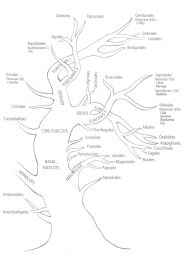In contrast, the 'Petra bean' looks quite different, and obviously remained compact during the process of 'archaic carbonization'. It is for sure not a coffee bean and thus destroyed a great fantasy.
For several reasons I (twb) concluded that the 'Petra bean' is most likely the half of one laurel seed (Laurus nobilis L.). This species is part of the local flora and the folklore medicine in Jordan. Moreover, the pyrophilic knows that laurel is an excellent fire starter – too bad about the laurel wreath...
Although the coffee bean was – to mimic the harsh conditions in the ancient fireplace – strongly carbonized, we can still well recognize the typical invagination of the endosperm coated with the 'shiny' silver skin. Moreover, we see large gaps presumably formed at the sites of first and second crack.
In the meantime µCT has been proven a valuable technique to study the influence of roasting on the coffee bean's microstructural change, that is primarily the architecture of the micropore system (Pittia et al. 2011, Frisullo et al. 2012), which is considered crucial to the final quality of the roasted product (Schenker et al. 1999, 2000).


At the 2008 institution's Christmas party, Christiane Jacquat, Archaeo-botanist, told me (twb) that she had found among date palm and grape seeds a coffee-bean-like seed in debris material present in room 1 of the ancient mansion ez-Zantur IV in Petra. Subsequent radiocarbon dating made clear, that the possible coffee bean, carbonized most likely in the fire place, was 2000 years old. Since it seemed imperative not to destroy the 'rare bean', Chahan Yeretzian suggested to scan it non-destructively. This was achieved in spring 2010 by Sebastian Friess, former project leader at Gloor Instruments AG, Switzerland, using X-ray computer microtomography (µCT). Of course, an experimentally carbonized coffee bean served as control in this study, which was a novum, since at that time comparable reports on coffee were lacking.
a short side-trip into history

When did Homo sapiens sip at his/her first coffee brew?
So far, the first account on coffee consumption is the 15th century AD, i.e. the 9th century of the Hegira. However, there is little doubt that coffee had been used by humans since immemorial days either as food – provoked and guided by observations on other mammals feeding on this commodity – or also as an ’innovative’ drink. Theoretically, even roasting the coffee bean could have been discovered in the neolithic if not earlier, when the dung of domesticated goats, craving for coffee fruits, was used as fuel, and thus signaled the presence of a pleasantly aromatic component (Beatrice Häsler, personal communication). Of course, animal droppings were primarily employed as fertiliser. Worth to mention is their use for tempering the pottery which inevitably made our ancestors to outstanding analysts of plant seeds (see London 1981 and references cited therein ).
The 'Caffeines'
The
Caffeine Plants


